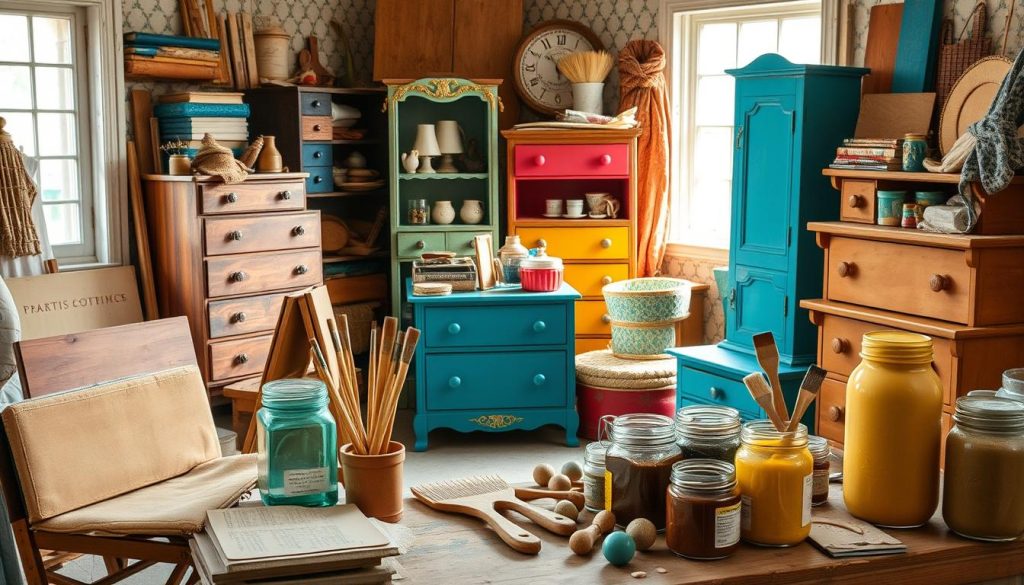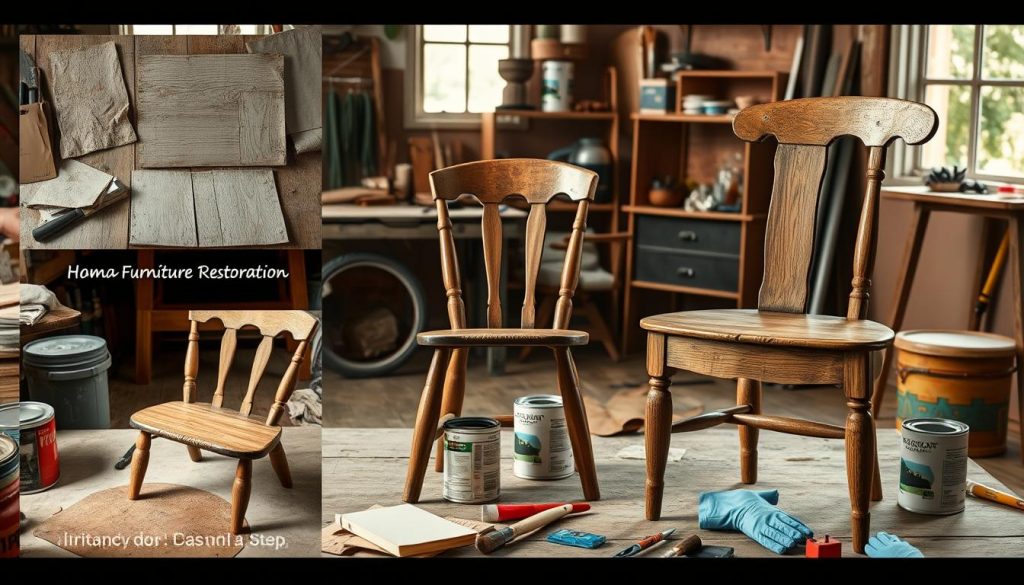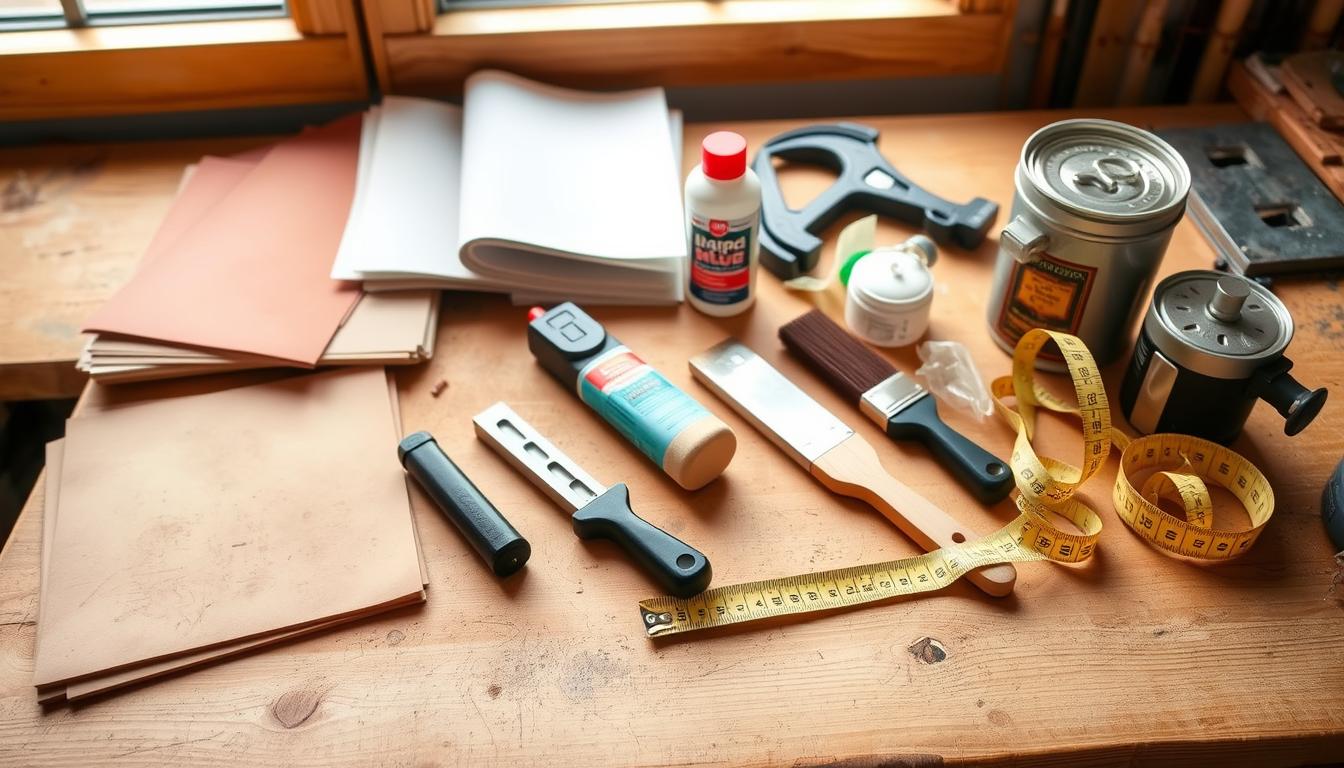Furniture Restoration: A Complete Guide for Homeowners
Have you thought about the secrets in your antique dresser? Or what tales your dining room chairs hold? The answer could be in their weathered surfaces and creaking joints. It’s found through furniture restoration. This art is for everyone. It mixes love for antique furniture care with the joy of making things better.
Brian D. Hingley’s guide helps even beginners. No experience? No problem. With over 20 years of know-how, Hingley shares old traditions and new tricks. Every step is practical for today’s DIYer.
Reviving furniture isn’t just about the past. It’s about a green future for your belongings. So, clean that old armoire and ready your tools. It’s restoration time!
Key Takeaways
- Understanding the basics of furniture restoration and preservation
- Safe and effective methods for different restoration processes
- The environmental benefits of choosing restoration over buying new
- Exclusive insights from Brian D. Hingley, a seasoned restoration expert
- Advantages of modern restoration techniques like laser cleaning and 3D printing
- A resourceful guide with over 500 color step-by-step photographs for aid in restoration
Why Focus on Furniture Restoration?
Restoring furniture has many benefits, like keeping sentimental value and saving money. By restoring, you keep the piece’s unique story and help the planet. Let’s look at why restoring furniture is great for homeowners.
Environmental Impact: Restoring furniture means less new stuff is needed. This reduces our carbon footprint. It saves trees and cuts down on waste, helping the earth.
Cost Efficiency: It costs less to restore furniture than to buy new. This choice saves money while still giving you beautiful, quality furniture.
Sentimental Value: Furniture often holds special memories. Restoring these pieces lets us keep these memories alive. They can be enjoyed by future generations.
Aesthetic and Customization: Restored furniture can be the highlight of a room. It looks unique. You can also make it fit your style and home perfectly.
Below is a table that shows the benefits of restoring furniture:
| Benefit | Description |
|---|---|
| Eco-Friendly | Reduces demand for new materials, lowers environmental impact. |
| Cost-Effective | Saves money compared to buying new, high-quality furniture. |
| Preserves Heritage | Keeps sentimental items and memories alive in the home. |
| Customizable | Options to choose specific fabrics, finishes, and colors. |
| Unique Aesthetic | Offers distinctive style that enhances home decor. |
Choosing to restore furniture can really change your home. It adds a personal touch and shows you care about our planet.
DIY vs Professional Help
When deciding on furniture fixing, people wonder if they should try it themselves or get experts. The decision depends on things like money, how much time you have, if you know how, and the furniture’s worth.
If you’re thinking about fixing furniture yourself, it can save money and feel rewarding. Doing it yourself can cut costs by up to half than hiring a pro. It’s great for small fixes or if you want to make it special. You choose what to use and how to do it.
But, hiring pros means getting folks who really know furniture, especially valuable or old items. Companies like Furniture Medic and Schoenbauer have lots of experience. They make sure things stay real and get even more valuable. They work with care and detail that’s hard to match on your own.
| Consideration | DIY Restoration | Professional Restoration |
|---|---|---|
| Cost | Up to 50% cheaper | Higher initial cost, but includes expert handling |
| Time and Effort | Time-consuming, labor-intensive | Efficient, time-saving |
| Expertise Required | Limited to personal knowledge | Professional skills in complex and delicate areas |
| Quality of Results | Potential for mistakes | Consistently high-quality, reduced risk of errors |
| Handling Complexity | Not ideal for complex repairs | Excellent, especially for complex and antique items |
| Mess and Clean-up | More hands-on mess management | Professional handling of dustless sanding and refinishing |
Choosing between DIY and expert help means thinking about the damage, the furniture type, and if you feel okay doing it. Think about how DIY mistakes might lower your furniture’s value. Also, pros keep things clean. This can help you choose the best path for both your wallet and your furniture.
How to Save Money
Adding affordable furniture restoration to your home updates can save money and feel rewarding. It lets you pick projects wisely.
Beginners at restoring furniture should try yard sales or thrift stores for cheap finds. These items, like solid wood pieces, clean up well with easy fixes. You spend less but get great results, fitting economical home decor plans.
DIY efforts cut down costs and let you be creative. Refinishing furniture saves it from waste, helping the planet. This choice lessens the need for new stuff, cutting down on factory pollution.
| Cost Element | Restoration | New Purchase |
|---|---|---|
| Initial Item Purchase | $30 (thrift store find) | $300 (new item) |
| Materials (paint, sandpaper, etc.) | $50 | N/A |
| Total Cost | $80 | $300 |
| Environmental Impact | Reduced | Increase |
Budget-friendly restoration tips are more than making things look good. They’re about wise choices that work well and cost little.
Always wear the right safety gear, like gloves and glasses, when working. This keeps you safe and makes your furniture last longer.
In the end, affordable furniture restoration improves your space, sparks creativity, and saves money. It’s great for those who care about their budget and the earth.
Step-by-Step Upgrades
Starting a furniture restoration project can make old pieces look new. It also lets you use different refinishing techniques. These are important for furniture repair and restoring woodwork. This guide will help homeowners through each step.

- Assess the Damage: First, carefully look at the furniture. Check if parts are loose or if the finish is peeling. This tells you what repairs are needed.
- Clean Thoroughly: Clean the wood with a special soap. This gets rid of dust and old wax. It prepares the wood for new treatments.
- Strip Old Finishes: Find out what the old finish is. Then, pick the right way to remove it. Use chemicals for lacquer. For paint, use heat and chemicals.
- Conduct Structural Repairs: Fix any loose parts or cracks. You might need to take apart joints, clean them, use wood glue, and clamp them. Fill cracks with wood filler.
- Sanding: After stripping and fixing, sand the wood. Use fine-grit sandpaper. This makes it smooth and ready for a new finish.
- Apply New Finishes: Pick a finish that fits the wood and your style. Put on at least three coats. Let each coat dry well.
- Final Inspection and Touch-Ups: Look over the piece for any spots you missed. Add a final coat to protect the wood and make it look good.
Safety is very important when restoring furniture. Always wear safety gear like masks and goggles. Make sure your work area has good air flow. This keeps you safe from dust and fumes.
These steps can help beginners in furniture repair and restoring woodwork. You can get professional results. This brings old furniture back to life with your skills in refinishing techniques.
Final Tips for Success
To end this guide on furniture fixing, we must stress the need for preparation, patience, and precision. Having a space with lots of air is key. Also, make sure you’ve got the right tools and materials. Always wear safety gear to protect yourself while working. Restoring furniture brings old treasures back to life and is good for the planet too.
Choosing to fix furniture is both smart and good for the environment. I’ve learned that good quality matters. Spend on the best finish to make sure your furniture looks great and lasts long. The final steps, like the right sealant or a last wax coat, really matter. They can change how your furniture looks.
I began in a small space and grew to two big shops. The secret? Always be detailed and patient with every furniture piece. Every item has its own story. With these furniture maintenance tips, you can keep your furniture’s story alive. From picking the right item to getting good at cleaning and fixing it, each step lets you grow your skills and be creative. This guide has given you everything you need to succeed in fixing your furniture.



